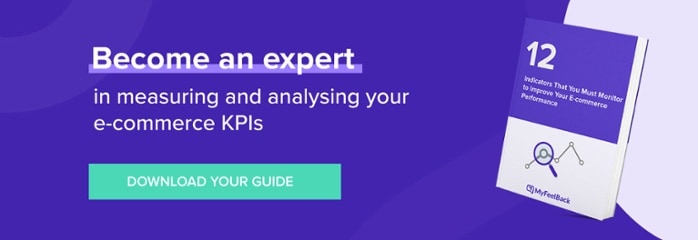Some e-commerce companies just seem to have a six sense when it comes to knowing what customers want and how to optimize online platforms to deliver accordingly. These companies have perfected the practice of collecting and implementing customer feedback. Amazon, Netflix, and Uber, for example, recognize that, without question, gathering and using customer knowledge is...
Some e-commerce companies just seem to have a six sense when it comes to knowing what customers want and how to optimize online platforms to deliver accordingly.
These companies have perfected the practice of collecting and implementing customer feedback. Amazon, Netflix, and Uber, for example, recognize that, without question, gathering and using customer knowledge is crucial for business success. And they aren’t the only e-commerce businesses to recognize the value of customer insights. Recent research from Esteban Kolsky, founder of thinkJar, a customer strategy consulting firm, shows that 70% of companies that deliver best-in-class customer experience do so thanks to customer feedback.
Gathering customer insights is key to providing an exceptional online customer experience, a practice that all e-commerce businesses should employ, even though many either don’t or fail to do well. But in today’s e-commerce world, online businesses must develop and manage operating models around a deep understanding of customers, what they value, and what they contribute to the profitability of the company. This customer-centric approach to business involves:
- Recognizing and responding to different customer segment needs.
- Delivering a superior customer experience at every touch point across the customer life cycle.
- Talking to customers and acting on their feedback.
- Placing the customer at the center of all decisions.
Research highlights how important it is for e-commerce businesses to give customers a superior online experience. [24]7 reports that a third of customers will abandon an e-commerce site if it fails to provide a seamless, customer-centric experience. With nearly 90% of customers describing a great customer service experience as one in which their needs have been anticipated, self-service has been optimized, or assistance has been made readily available, it’s clear that today’s customers value above all ease and efficiency.
Develop a Customer Insights Strategy
Listening to customers is an inherent part of taking care of them. It’s difficult to know how you can improve their experience if you don’t have an attentive feedback system in place, regularly conducting meaningful customer surveys to find out what they think.
If you carefully listen to your customers, you’ll find that they can help you develop a product or service that other customers love. Although they cannot single-handedly steer your product towards innovation, a truly customer-centric company will take advantage of the fact that their customers do often know what they want.
To gather the most accurate customer insights as possible, survey your online visitors consistently to get their feedback on your offerings as well as their perception of your company. To improve your customer experience and create a clear point of differentiation with your competitors, focus on the following three areas to generate relevant, actionable insights.
Know Your Customer
What you need to find out: Who is s/he? What does s/he need? What problems does s/he have to solve? What improvements does s/he look for? What does s/he value?
How your customers will benefit: Exceeding customer expectations should be a primary goal for your online venue. The only way to do this is to know who your customers are and what exactly they need before they tell you.
According to the previously mentioned [24]7 report, customers are most loyal when they see a company has already anticipated their needs. Research from Forrester supports this claim, reporting that 72% of customers prefer to use self-service support, rather than phone or email support, to find answers to their questions. This means your business needs to maintain a knowledge base of frequently asked questions or common problems, based on customer feedback, with which to empower customers so they can efficiently resolve issues on their own.
If you know what customers need most, it’s easier to match their needs to the benefits your business can offer. Ian McAllister, former Director at Amazon, once attributed the company’s success to what he called the “working backwards” approach which involves, first, collecting and analyzing customer feedback and, then, developing products and services based on what customers need and want. Customers can easily access the exact information they need when they need it most because Amazon knows what visitors are looking for. Customers have already told them.
Know your product, service, or idea
What you need to find out: How does your product or service solve a problem or offer improvement? What value does it offer the customer? What do they like most about your product or service?
How your customers will benefit: According to Aberdeen Group’s research report, Optimizing Lead-to-Win, best-in-class businesses are better in three specific areas:
- Overall product and service knowledge
- Understanding clients’ and prospects’ personal/business challenges
- Ability to map solutions to challenges
In other words, best-in-class companies have clear knowledge of customers’ needs and how their products and services solve those needs. These companies know exactly what value they bring to customers.
The more you know about your own product or service, and how it will bring value to customers, the more you will sell. Once you being surveying customers to find out what they want, what they don’t care about, and how you make their life better, you will know whom your target audience is. You will, in effect, make yourself more relevant, better able to match what you have to offer to the right customers.
And keep this in mind: 60% of online shoppers like when stores use personal information to provide a more relevant shopping experience. To be successful in today’s marketplace, providing a personalized experience is mandatory.
Know your competitors
What you need to find out: How does your product or idea create more value than competing ones? What is the number one thing you should never stop doing? What was it that ultimately made them decide to buy from you? How likely is it that they will recommend your product or service to a friend or colleague?
How your customers will benefit: E-commerce websites currently comprise 10-12% of the Internet. That’s over 100 million online business all over the world with whom online merchants must compete to gain a share of the estimated $1.5 trillion online market. So, an important question you should be asking yourself is how you can differentiate your business to become – and stay – competitive in an increasingly crowded ecommerce landscape.
Why not just ask your customers what they perceive to be your strongest point of difference. Their feedback will provide insights into the distinguishing features of your business’s product or service. Do you make their lives better? Easier? How? Customers will let you know which attributes you should be highlighting more prominently to stay ahead of the competition. Likewise, customers can tell you why they did not buy from you, providing insights into how you are falling behind the competition.
If you want to determine where your ecommerce business stands, the Net Promoter Score metric is an especially efficient way to find out. Survey customers to find out how likely they are to recommend your ecommerce website to others. Respondents use a 1-10 rating scale with 10 being extremely likely to recommend and 0 being not at all likely.
Then, separate the scores into three categories:
- Promoters: loyal customers who keep buying from you and urge friends to do the same (scores of 9 and 10)
- Passives: satisfied but unenthusiastic customers who can be easily wooed by the competition (scores of 7 and 8)
- Detractors: unhappy customers who are ‘at risk’ and spread the majority of bad word of mouth (scores 6 and below)
Calculate your Net Promoter Score by finding the percentage of promoters, then subtracting the percentage of detractors. The final percentage is your NPS. If you want to know more about each user’s response, follow up with an open-ended question. This will give you more insight into why you are or are not competitive. Just ask Apple, long a proponent of this particular metric.
Use Customer Insights to Create Your Competitive Advantage
Before ecommerce existed, customers were naturally attracted to stores which offered exceptional customer service and a satisfying shopping experience. Today, these same features are just as important for customers who shop via ecommerce sites. By making it easy for your customers to shop, you won’t be leaving money on the table, and more of your customers are likely to become repeat customers.
When you know your ideal customer better and really understanding their needs and wants, you are in a better position to provide the personalization that today’s customers are seeking. In turn, your business will develop the competitive edge it needs to thrive.








